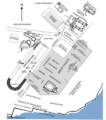Template:Selected anniversaries/January 13: Difference between revisions
No edit summary |
No edit summary |
||
| (5 intermediate revisions by the same user not shown) | |||
| Line 1: | Line 1: | ||
<gallery> | <gallery> | ||
|| *** DONE: Pics *** | |||
File:Constantinople_imperial_district.png|link=Nika riots (nonfiction)|532: The [[Nika riots (nonfiction)|Nika riots]] begin in Constantinople, with nearly half the city being burned or destroyed and tens of thousands of people killed over the next several days. | File:Constantinople_imperial_district.png|link=Nika riots (nonfiction)|532: The [[Nika riots (nonfiction)|Nika riots]] begin in Constantinople, with nearly half the city being burned or destroyed and tens of thousands of people killed over the next several days. | ||
| Line 10: | Line 12: | ||
||1845: Félix Tisserand born ... astronomer and academic. Tisserand's principal work, ''Traité de mécanique céleste'', documents the work of Laplace and other astronomers since his time. Pic. | ||1845: Félix Tisserand born ... astronomer and academic. Tisserand's principal work, ''Traité de mécanique céleste'', documents the work of Laplace and other astronomers since his time. Pic. | ||
||1858: Oskar Minkowski born ... biologist and academic ... research on diabetes. Pic. | |||
||1858: Oskar Minkowski born ... biologist and academic. | |||
||1864: Wilhelm Wien born ... physicist and academic, Nobel Prize laureate ... used theories about heat and electromagnetism to deduce Wien's displacement law, which calculates the emission of a blackbody at any temperature from the emission at any one reference temperature. Pic. | ||1864: Wilhelm Wien born ... physicist and academic, Nobel Prize laureate ... used theories about heat and electromagnetism to deduce Wien's displacement law, which calculates the emission of a blackbody at any temperature from the emission at any one reference temperature. Pic. | ||
||1870: Ross Granville Harrison born ... biologist and anatomist. Tissue culture. Pic. | ||1870: Ross Granville Harrison born ... biologist and anatomist. Tissue culture. Pic. | ||
File:Erhard Schmidt.jpg|link=Erhard Schmidt (nonfiction)|1876: Mathematician [[Erhard Schmidt (nonfiction)|Erhard Schmidt]] born. He will make important contributions to functional analysis and modern set theory. | File:Erhard Schmidt.jpg|link=Erhard Schmidt (nonfiction)|1876: Mathematician [[Erhard Schmidt (nonfiction)|Erhard Schmidt]] born. He will make important contributions to functional analysis and modern set theory. | ||
||1882: Wilhelm Mauser dies ... engineer and businessman, co-founded the Mauser Company. Pic. | |||
||1882: Wilhelm Mauser dies ... engineer and businessman, co-founded the Mauser Company. | |||
||1895: Johannes (Jan) Martinus Burgers born ... physicist. He will discover Burgers' equation, the Burgers vector in dislocation theory, and the Burgers material in viscoelasticity. Pic. | ||1895: Johannes (Jan) Martinus Burgers born ... physicist. He will discover Burgers' equation, the Burgers vector in dislocation theory, and the Burgers material in viscoelasticity. Pic. | ||
File:Alfred Dreyfus age 76.jpg|link=Dreyfus affair (nonfiction)|1898: Émile Zola's ''J'accuse…!'' exposes the [[Dreyfus affair (nonfiction)|Dreyfus affair]]. | File:Alfred Dreyfus age 76.jpg|link=Dreyfus affair (nonfiction)|1898: Émile Zola's ''J'accuse…!'' exposes the [[Dreyfus affair (nonfiction)|Dreyfus affair]]. | ||
||1901: Wilhelm Hanle born ... experimental physicist. He is known for the Hanle effect. During World War II, he made contributions to the German nuclear energy project, also known as the Uranium Club. Pic. | ||1901: Wilhelm Hanle born ... experimental physicist. He is known for the Hanle effect. During World War II, he made contributions to the German nuclear energy project, also known as the Uranium Club. Pic. | ||
| Line 70: | Line 62: | ||
||1953: An article appears in Pravda accusing some of the most prestigious and prominent doctors, mostly Jews, in the Soviet Union of taking part in a vast plot to poison members of the top Soviet political and military leadership. | ||1953: An article appears in Pravda accusing some of the most prestigious and prominent doctors, mostly Jews, in the Soviet Union of taking part in a vast plot to poison members of the top Soviet political and military leadership. | ||
||1968: Johnny Cash performs live at Folsom State Prison | |||
|| | |||
|| | File:Steely Kubrick.jpg|link=Steely Kubrick|1977: American rock band and film production company '''[[Steely Kubrick]]''' begins world tour. | ||
||1993: Space Shuttle program: Endeavour heads for space for the third time as STS-54 launches from the Kennedy Space Center. | ||1993: Space Shuttle program: Endeavour heads for space for the third time as STS-54 launches from the Kennedy Space Center. | ||
| Line 88: | Line 78: | ||
||2017: Magic Alex dies ... electronics engineer. Pic. | ||2017: Magic Alex dies ... electronics engineer. Pic. | ||
</gallery> | </gallery> | ||
Latest revision as of 18:02, 7 February 2022
532: The Nika riots begin in Constantinople, with nearly half the city being burned or destroyed and tens of thousands of people killed over the next several days.
1876: Mathematician Erhard Schmidt born. He will make important contributions to functional analysis and modern set theory.
1898: Émile Zola's J'accuse…! exposes the Dreyfus affair.
1902: Mathematician Karl Menger born. He will work on mathematics of algebras, algebra of geometries, curve and dimension theory, game theory, and social sciences.
1906 Jan. 13: Physicist and academic Alexander Stepanovich Popov dies. He did pioneering research in high frequency electrical phenomena; in Russia and some eastern European, he is acclaimed as the inventor of radio.
1924: Physicist and academic Georg Hermann Quincke dies. He conducted prolonged research on the influence of electric forces upon the constants of different forms of matter, modifying the dissociation hypothesis of Clausius.
1977: American rock band and film production company Steely Kubrick begins world tour.






